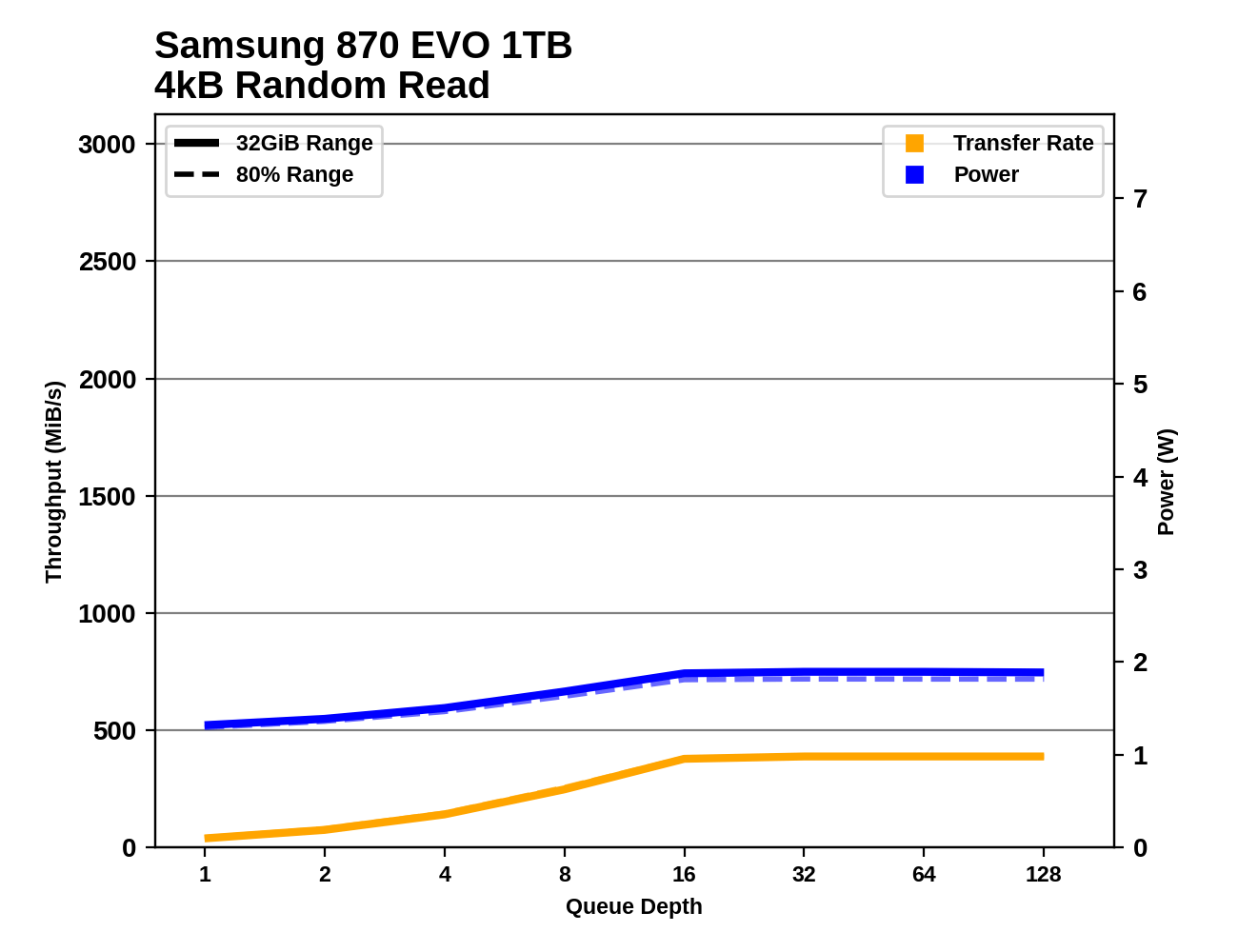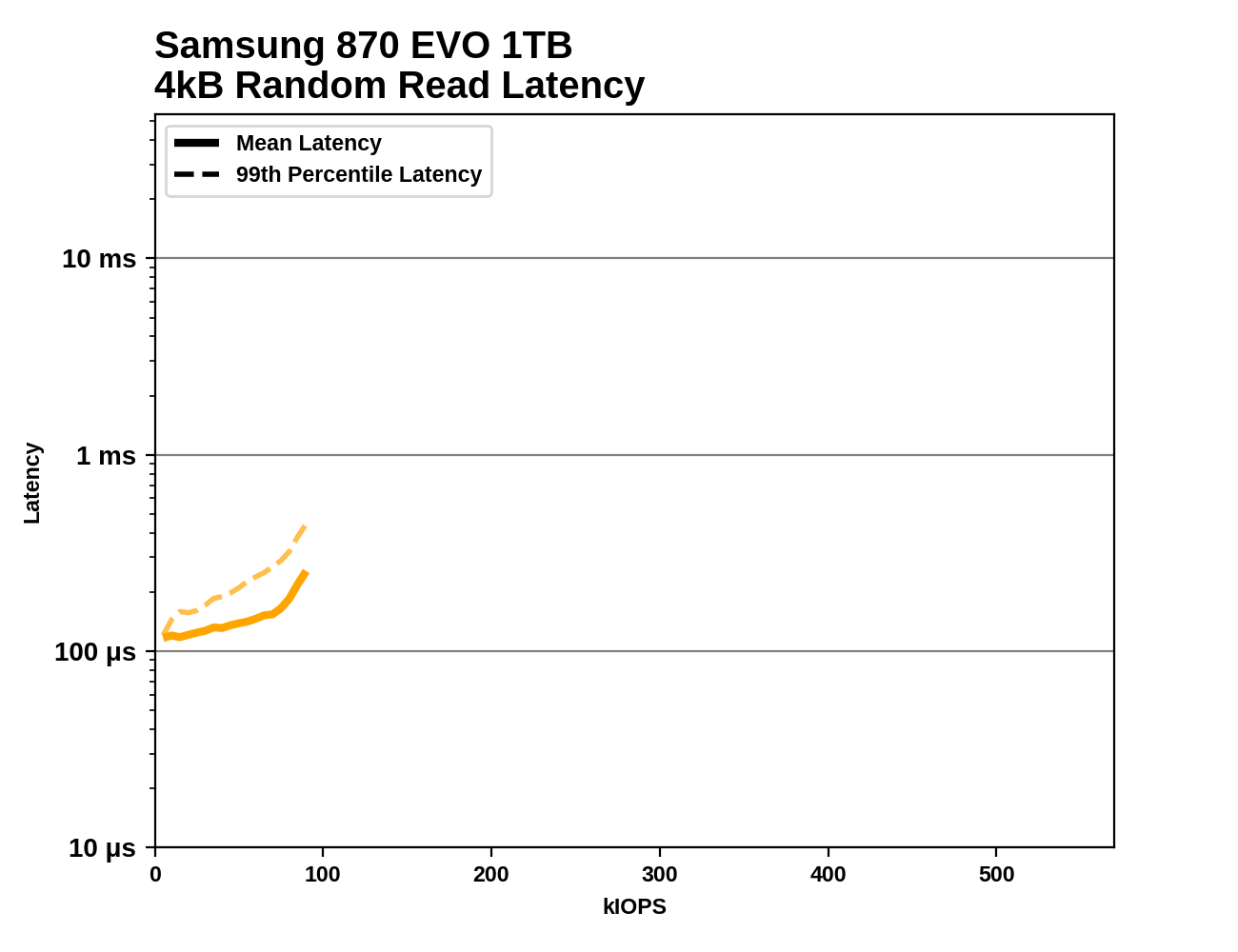The Samsung 870 EVO (1TB & 4TB) Review: Does the World Need Premium SATA SSDs?
by Billy Tallis on February 17, 2021 8:00 AM ESTBurst IO Performance
Our burst IO tests operate at queue depth 1 and perform several short data transfers interspersed with idle time. The random read and write tests consist of 32 bursts of up to 64MB each. The sequential read and write tests use eight bursts of up to 128MB each. For more details, please see the overview of our 2021 Consumer SSD Benchmark Suite.
 |
|||||||||
| Random Read | Random Write | ||||||||
| Sequential Read | Sequential Write | ||||||||
Our burst IO tests show little to no performance differences between the Samsung 870 EVO and other top SATA SSDs. The 1MB sequential transfers are already hitting the SATA throughput limits even at QD1, and the 4kB random IOs are at best marginally improved over Samsung's previous generation. Samsung's slight improvement to random read latency is enough to catch up to Micron's as shown by the Crucial MX500, but a 10% gain hardly matters when NVMe drives can double this performance.
Sustained IO Performance
Our sustained IO tests exercise a range of queue depths and transfer more data than the burst IO tests, but still have limits to keep the duration somewhat realistic. The primary scores we report are focused on the low queue depths that make up the bulk of consumer storage workloads. For more details, please see the overview of our 2021 Consumer SSD Benchmark Suite.
 |
|||||||||
| Random Read | Random Write | ||||||||
| Sequential Read | Sequential Write | ||||||||
On the longer synthetic tests that bring in some slightly higher queue depths, the improved random read performance of the 870 EVO is a bit more clear. In one sense it is impressive to see Samsung squeeze a bit more performance out of the same SATA bottleneck, but we're still talking about small incremental refinements where NVMe enables drastic improvements. Aside from random reads, the 870 EVO's performance improvements are exceedingly minute and it should be considered essentially tied with most other recent mainstream TLC SATA drives.
 |
|||||||||
| Random Read | Random Write | ||||||||
| Sequential Read | Sequential Write | ||||||||
Power consumption is one area where Samsung could theoretically offer more significant improvements despite still being constrained by the same SATA interface, but the 870 EVO doesn't really deliver any meaningful improvements there. The 4TB model is consistently a bit less efficient than the 1TB model on account of having more memory to keep powered up, but when comparing the 1TB model against its predecessor and competing drives there's nothing particularly noteworthy about the 870 EVO. SK hynix's Gold S31 has a modest efficiency advantage for random IO while Samsung is technically the most efficient of these SATA drives for sequential IO.
 |
|||||||||
| Random Read | |||||||||
| Random Write | |||||||||
| Sequential Read | |||||||||
| Sequential Write | |||||||||
The queue depth scaling behavior of the 870 EVOs is almost identical to the 860 EVOs and still quite typical for mainstream SATA drives. For random reads the 870 EVOs saturate around QD16, while for random writes QD4 suffices. On the sequential IO tests there's only a small performance gain from QD1 to QD16, and the more interesting question is how stable performance is through the rest of the sequential tests. The 1TB 870 EVO seems to run out of SLC cache a bit earlier than the 860 EVO when the sequential write test is running on an 80% full drive, but the 4TB model has plenty of cache to finish out that test at full speed.
Random Read Performance Consistency
This test illustrates how drives with higher throughput don't always offer better IO latency and Quality of Service (QoS), and that latency often gets much worse when a drive is pushed to its limits. This test is more intense than real-world consumer workloads and the results can be a bit noisy, but large differences that show up clearly on a log scale plot are meaningful. For more details, please see the overview of our 2021 Consumer SSD Benchmark Suite.
 |
|||||||||
Consistent with most of our other read performance tests, the Samsung 870 EVO shows slightly better average and 99th percentile random read latencies than most of its SATA competition. Even some of the entry-level NVMe drives that can deliver higher random read throughput than is possible for the 870 EVO still have clearly higher latency across most or all of the throughput range that the 870 EVO can cover. A QLC-based or DRAMless TLC NVMe SSD can potentially offer far higher throughput than any SATA SSD, but clearly beating the 870 EVO on both throughput and latency requires stepping up to a more mainstream NVMe design with DRAM and TLC NAND.










136 Comments
View All Comments
Wereweeb - Wednesday, February 17, 2021 - link
They made a major update. No one cares about SATA Express. That you don't even know about it only goes to show that no one cares, there's no need or use for it.SATA is plenty enough for Hard Drives, and SSD's are going to keep using M.2, U.3, and other PCIe ports. There's no need for a port that isn't going to be used by anyone.
If anything, they could theoretically run spinning rust off an x1 PCIe 3.0 (Or even 2.0) connector, but that's also not really needed.
If you want consumer motherboards to have U.3 connectors, then say that. And I'd agree. I never like bare PCB's where they're not necessary.
Lord of the Bored - Wednesday, February 17, 2021 - link
I ABSOLUTELY want U.2 connectors on motherboards, and U.2 drives priced for mass-market sales.It won't happen, because the manufacturers want a hard line drawn between home-use and business-use hardware so they can price-gouge for business hardware. Mass-market U.2 drives would ruin their pricing strategy.
Wereweeb - Thursday, February 18, 2021 - link
They don't really need to, consumer SSD's are already shit for most enterprise applications, and will be plain garbage when it's all just QLC.Billy Tallis - Thursday, February 18, 2021 - link
Consumer U.2 drives wouldn't ruin the enterprise SSD market, because the form factor is a much less important difference than the fact that consumer SSDs have SLC caching and enterprise SSDs don't.Consumer U.2 drives would fail because the market is simply too small. The number of consumers who can actually afford and want 3+ NVMe SSDs in their desktop (and aren't already on a HEDT system) is too small to justify bringing a new category of products to market.
Spunjji - Friday, February 19, 2021 - link
Changing the SATA standard in a way that wrecks backwards compatibility would be pointless - U.2 is already an alternative standard that does that.It's dead. It's a silly way to access flash devices.
Gigaplex - Wednesday, February 17, 2021 - link
Or they'd just switch to using SAS in those devices.flyingpants265 - Thursday, February 18, 2021 - link
The suggestion for hard drives was to double the amount of heads/platters per drive to get costs down even further, I think this decreases reliability too but reduces overhead costs for datacenters because it's fewer drives.8 tb, 10 TB and 12 TB drives are more expensive per gb than the two terabyte drives.... Prices haven't gone down since 2010. I should be able to walk in and get a 8tb drive for $89. The markets really crapped out.
Spunjji - Friday, February 19, 2021 - link
HDD prices never really recovered after the 2011 floods in Thailand. By the time the impact was over, SSDs were eating their lunch, and the incentive to keep dropping prices went away forever.Jorgp2 - Wednesday, February 17, 2021 - link
SAS connectors provide power and up to 4x PCI-E lanes.Kevin G - Wednesday, February 17, 2021 - link
At the time SATA was developed, it made sense. Times of course have changed with SATA now feeling more of a legacy technology. It'll continue to hang around as the protocols it was built upon (AHCI etc.) are present in legacy OS where as NVMe support may not be there. Similarly there is no support for removable media though leveraging USB for that now is trivial. Main barrier for the formal death of SATA is still cost as NVMe still carries a slight premium over SATA and consumer systems have limited PCIe connectivity.